Two New Ions: ASUS AT3N7A-I and ASRock Ion 330
by Anand Lal Shimpi on August 28, 2009 12:00 AM EST- Posted in
- Motherboards
The first companies to support non-Intel products are those that have the weakest relationships with Intel. How Intel is able to ensure this is the crux of the AMD v. Intel antitrust suit, but that’s not the point of today’s story.
NVIDIA’s Ion platform, at least when first introduced, combined Intel’s Atom CPU with NVIDIA’s GeForce 9300/9400M integrated graphics chipset. This offered better performance and modern features compared to Intel’s 945G chipset, what Intel was bundling with Atom. Intel still sold the CPUs but it lost the chipset sale and got upstaged by NVIDIA. Intel doesn’t like being upstaged by anyone.
Intel’s partners are very cautious when supporting a product like Ion. They don’t want to appear too eager and thus Intel’s closest partners wait to see if a product like Ion succeeds before attempting to jump on the bandwagon.
Zotac built the first mini-ITX Ion motherboard. While Zotac builds several Intel motherboards, they are hardly considered a tier 1 motherboard manufacturer. Zotac doesn’t get preferential treatment by Intel and thus Zotac doesn’t have to worry about ruffling any feathers by releasing an Ion motherboard.
I can’t tell you how well the Zotac Ion has sold, but reading our review and user experiences with the board I can tell you that customers are pleased. It’s a good product and it fills a niche that Intel currently has no answer to. I’m not even sure if Pine Trail will address that market either.
ASUS was Intel’s launch partner for Atom. The first place you found the Atom processor was in ASUS’ Eee PC and Eee Box. The rest of the OEMs followed. It’s no surprise that ASUS didn’t build an Ion motherboard or an Ion netbook for that matter.
ASUS tested the waters with its value manufacturing brand earlier this year. ASRock put out an Ion system based on the Intel Atom 330 processor; note the use of the word system. The ASRock Ion differed from the Zotac Ion motherboard in that it was a barebones system complete with mini-ITX chassis, external power supply, 2GB of RAM, slim optical drive and 320GB hard drive. All you needed to add was an OS.
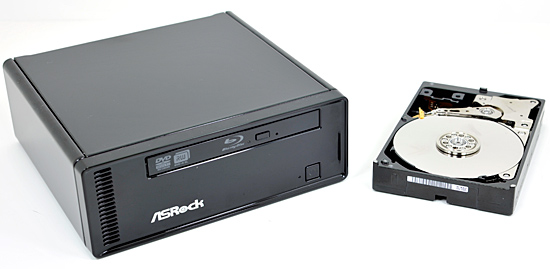
The ASRock Ion 330 (left) vs. a 3.5" HDD (right). We're not too far away from having P4-class PCs in the space of a hard drive.
The whole package sets you back $379.99 (ASRock does charge a slight premium for building the thing).
A couple of weeks ago we got word that the second mini-ITX Ion motherboard was coming our way. The manufacturer? ASUS. Ballsy.
Unlike the ASRock and Zotac Ion solutions, ASUS gave its Ion board a real and unnecessarily complex name. This is the AT3N7A-I:

Also gone is the North American favorite “Rock Solid, Heart Touching” phrase on the box. Instead we’re given two new slogans: Inspiring Innovation, Persistent Perfection (hooray for alliteration) and Perfectly suit your digital lifestyle.
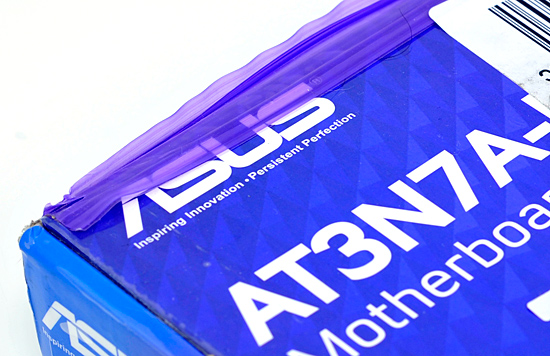
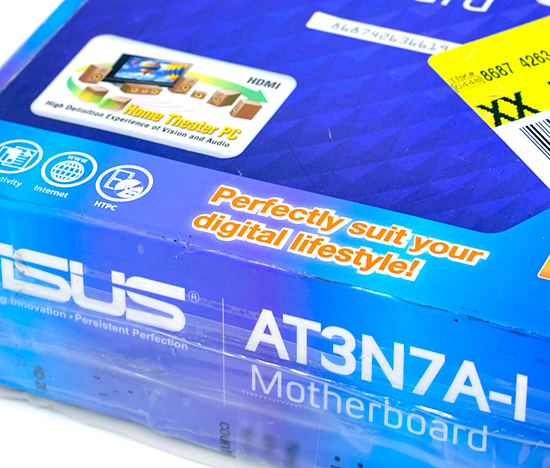
A Closer Look at the ASUS AT3N7A-I
ASUS’ Ion board doesn’t come with a power supply, it instead has a 24-pin ATX power supply connector and a 4-pin 12V connector for CPU power. The ASUS Ion is eerily similar to the Zotac board but with poorer color choices.
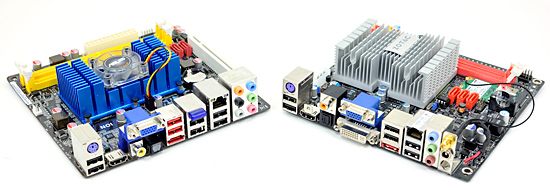
Zotac’s board has on-board WiFi, while ASUS’ board has on-board Bluetooth.

ASUS (left) vs. Zotac (right)
ASUS adds a ton more USB ports on the rear of the AT3N7A-I. You get a total of 8 USB ports (+2 more via an internal header), a single PS2 port, HDMI out, VGA out, coax/optical out, eSATA, Ethernet and the standard array of six 1/8” jacks for analog audio out.
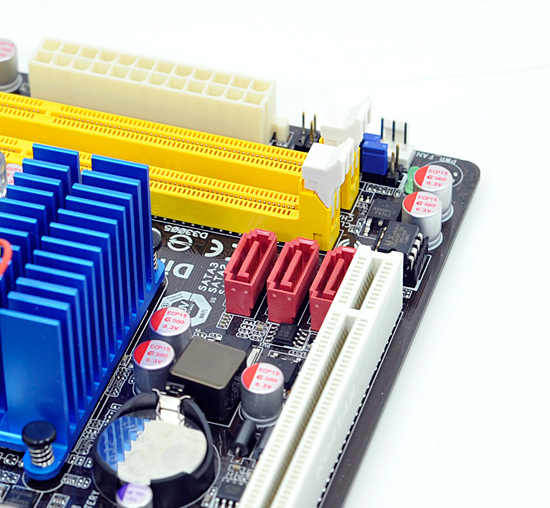
On the board itself there are three SATA ports, like the Zotac board, but ASUS also adds a standard 32-bit PCI slot (not PCIe).
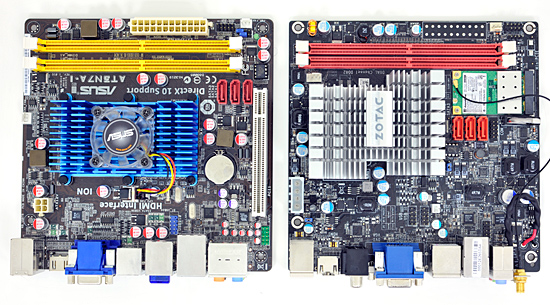
ASUS (left) vs. Zotac (right)
Two DIMM slots round out the package.










61 Comments
View All Comments
Titanius - Friday, August 28, 2009 - link
"While Acer offers the Aspire Revo, it only comes with a single-core Atom 230, a far less desirable option."What about the Acer Aspire Revo R3600? It has an Intel Atom 330, a 160GB HD and 2 GB of Dual-Channel RAM. Check it out: http://www.ncix.com/products/index.php?sku=41924&a...">http://www.ncix.com/products/index.php?...&man...
Fietsventje - Friday, August 28, 2009 - link
A pitty, no network interface benchmarks. Despite the overkill of the nVidia GPU, these boards would make the ideal start of a limited home server, and transferring files at gigabit speeds is no small feat for such a small processor ...mgrier - Friday, August 28, 2009 - link
Do you have data to support this? Between DMA both to the drive and the NIC and TCP checksum offloading, the CPU overhead of disk transfers should be minimal with an operating system and drivers that support all of the above. Assuming a single drive configuration, you should mostly be limited by transfer rate of the drive for large files. For smaller files, you should be limited by the drive's seek latency.JarredWalton - Saturday, August 29, 2009 - link
I'm not so sure it's the HDD CPU overhead so much as network drivers. I'd imaging these Atom CPUs could use a good 30-50% of the CPU for doing Gb transfers. However, as you are limited by the HDD to a maximum ~50MBps (unless you go SSD or at least a 7200RPM drive), you should probably only need 15-25% of the CPU. Would be interesting to see the results though. At least the Ion systems give you GbE, unlike all the netbooks I've tested.cliffman - Friday, August 28, 2009 - link
I am interested in seeing the performance of a mini-itx board that can support a quad core system. You can build a modern system for $500 instead of paying $350 for an atom system.MadMan007 - Sunday, August 30, 2009 - link
Considering those use any one of the regular LGA775 (atm - maybe we'll see some LGA1156 mITX boards) chipsets unless the board is just done poorly the performance would be the same as a full system with the same chipset and CPU. You'd just have the obvious tradeoff of expansion and possibly overclocking/enthusiast features.plext0r - Friday, August 28, 2009 - link
You mention the Acer Aspire Revo on the last page. Any word when and if Acer will release this box in the US? A single-core 230 is plenty of CPU horsepower for XBMC or MythTV when using Nvidia's binary drivers. Thanks!strikeback03 - Friday, August 28, 2009 - link
Hey, finally an Atom board with analog connections for more channels. Maybe I'll eventually replace the LF2 board in my carputer with this (and just keep the Scythe fan I already have).gipper - Friday, August 28, 2009 - link
Why in the world can't people just use bigger fixtures and bigger fans?It's like the xbox 360. Who cares if it's smaller than my receiver, it's A FREAKING JET ENGINE. Why can't they just bump the size up a bit and throw in a 120mm fan?
With these, what's wrong with bumping up the chasis to xbox1 size and going with a slower 80mm fan which will probably deliver more air flow at 800rpm than these 40mm fans at 6500rpm.
I can't believe that project leaders haven't caught on to this issue yet. They must have their quality assurance guys working in different rooms than the products they're testing, or they're testing them in the middle of the factory.
Abby - Wednesday, September 2, 2009 - link
For Manufacturing, Transportation and profits wise, small is da key.